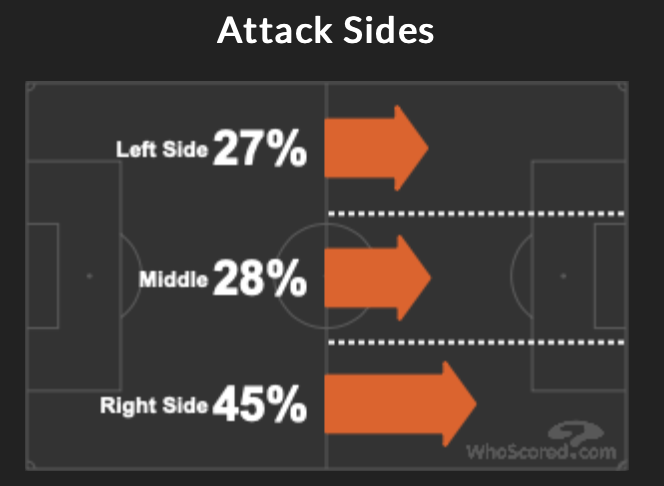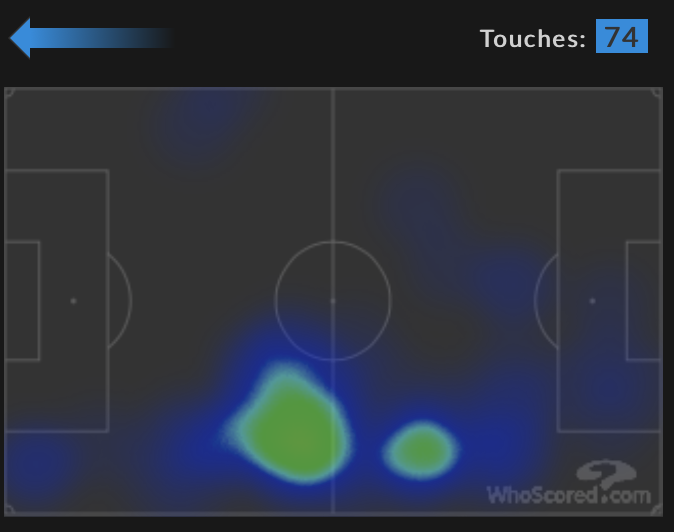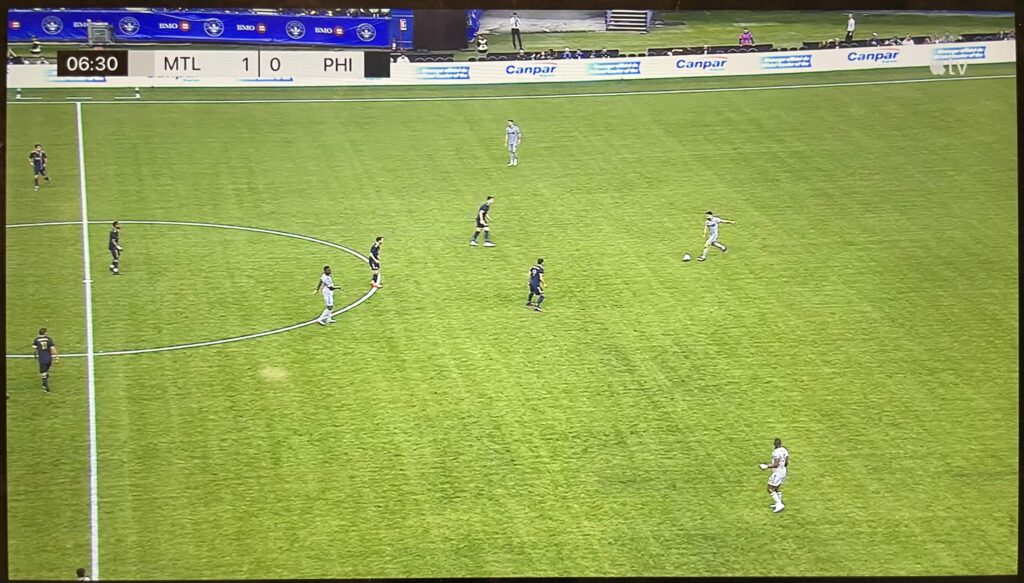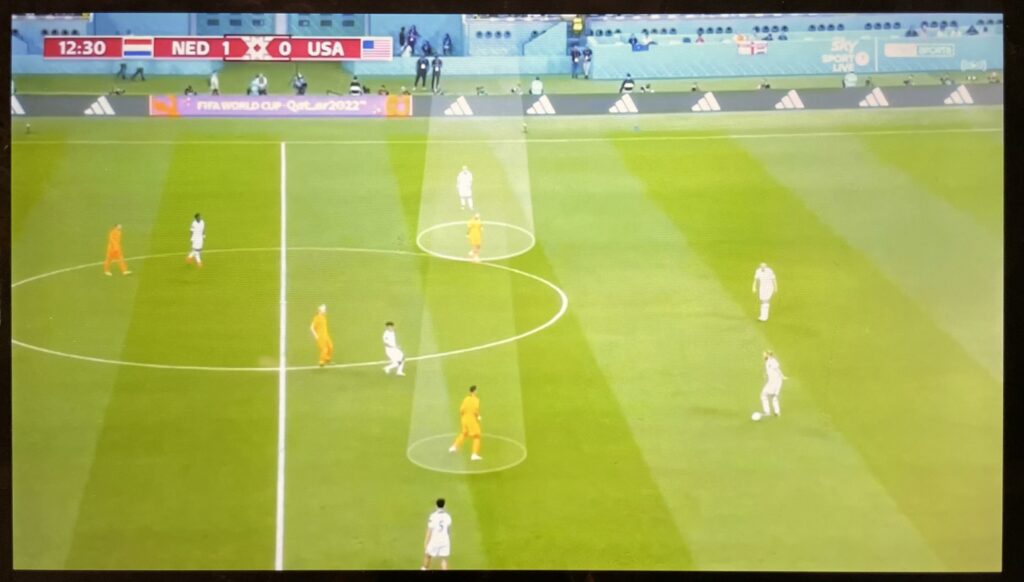Photo: Marjorie Elzey
In the course of watching a soccer match, sometimes things leap off the television screen right into the viewer’s lap.
On Saturday, there were plenty of three-dimensional objects being thrust forward: red cards, double VAR decisions, Canadian-accented homer announcers, and cut-aways from live action to closeups of coaches while all those other things were taking place (and more!).
While each of those topics might merit its own review, for this observer two other noteworthy things came to mind.
All right, all right, all right
Briefly mentioned on MLSSoccer.com ahead of the weekend’s fixtures, the Union are a right-sided attacking team.
Here’s what the Boys in Blue usually do (all stats courtesy of WhoScored.com):

They use Alejandro Bedoya and Olivier Mbaizo to drive traffic down the right side of the field. Then, whichever of the two right-footed players is making the overlapping run in that instance, they cut the ball back to whoever is making the near post run or the late-arriving run in the middle. When the Union aren’t in full-field transition – which by its definition is more chaotic – this is how it goes.
Against Columbus for example, a game in which the Union toyed with the Crew the way a cat does with a mouse, before eviscerating the visitors and displaying their carcass on the “Wipe your feet on this JAWN” welcome mat laid out by the Sons of Ben – a game in which the Union could have attacked from any direction they pleased and still dominated – they attacked only on the right side.

In their combined 111 touches, Wagner makes more than half (59) and basically none in the attacking third. Meanwhile, Mbaizo is all but parked at midfield, waiting for the ball to go forward so he can get involved in the attack.
To look at the Union over the last few years is to look at a fullback heat map that resembles this one – all right, all right, all right (Author’s note: the origin of this phrase, for fans of the movie Dazed and Confused, is somewhat interesting).
This isn’t a tactical revelation or anything new, but it’s worth continuing to note for one reason: the Union attacked on the left side in Montreal too. Yes, they did!

Attacking from right to left this time, look at Kai Wagner!
He’s miles up the field, twice as far as he was against Columbus, more than half of his entire heat map is in the opposition’s half. Despite Wagner being a record-setting attacker, him doing so from anything that isn’t a set piece is vintage – at least new again, noteworthy, something – but why?
Did the Union respect Montreal less than they did Columbus? Did they see something on film they were trying to exploit? Did none of that matter in the historic and crumbling Den of the Feet where the whole game stank like last week’s unwashed kit bag?
These are the questions, people.
Stuck in the middle with you
The Union’s formation, press, and joie de vivre are so well-documented it’s often difficult to find nuance in them. Writers at this site and friends at others locally joke that it was much easier to write about the team when they didn’t know who they were or what they were doing. This column, formerly the realm of tactical Mother Brain Adam Cann (the author is on the final boss of Metroid Dread right now, so please excuse any and all Nintendo references), used to be about what the Union changed from match to match. The writers are different now, as must be the analysis: the Union rarely change anything at all and to borrow a phrase from the National Football League, “are who we thought they were” – every match, all the time.
Because of that consistency, it’s equally easy to forget that there are other ways to win in soccer – that tactics sometimes don’t matter at all but sometimes matter a whole lot.
The Union’s narrow engagement was on full display on the slow, sticky, and unacceptably poor turf in Montreal over the week.

The first thing that leaps off the screen is, of course, how narrow the team’s shape is. If the Union’s shape in the midfield is a diamond, the cut is a marquise – tall, narrow, oblong, football-shaped. Now look at Leon Flach and Alejandro Bedoya – their bodies are facing inward. Why? They really want to see if Montreal will make a pass through their gauntlet so they can pounce. Of course no sane team would do that, but this is MLS and it does happen sometimes – the hosts played with a modicum of sanity on the night… mostly.
As well, the Union try and keep their back and front lines close to each other. A lot of coaches will tell you the rule for this tactic is 30 yards (as in don’t let there be more than 30 yards between the forwards and defenders) and though the visitor’s back line isn’t visible from this shot, the reader can expect that those players are just off stage left.
So: high, narrow, and compact.
Once the ball is played wide, which is exactly what the Union want, they slide their entire line in that direction to squeeze out an errant pass. This movement creates an avalanche of bodies, chaos, and turnovers, which is also exactly what the Union want. It’s not that the Union aren’t flexible tactically per se, simply that this version of defense is something they believe can be successful against every team they face in North America – they’ve done it against the Club Americas and Houston Dynamos in the region alike.
Sometimes soccer is played on other continents too. When that happens, some coaches opt for different strategies.
One tactical masterclass that has the same goal – forcing the opponent to make a bad decision but is otherwise antithetical to what the Union do – was the one put on by Dutch coach Luis van Gaal against the United States in the most recent World Cup (this video from Football Made Simple is excellent – and where the screen capture below comes from).

A much more accomplished footballing country, still the Dutch were worried about facing the Americans.
What were the Dutch worried about? Well, they were worried that the US would get the ball wide to the two most dynamics players on the team: Sergino Dest and Jedi Robinson (that the two most dynamic players in the pool were fullbacks is a conversation for another time). The Dutch worried that those players would beat their marks 1v1, and that the resulting scenario would create overloads on the ball side and space across it to exploit.
To address this, the Dutch pushed their attackers wide and into the passing lanes between the center backs and their forward-thinking fullbacks. They did this while pushing their midfielders high, following the team in white’s central options wherever they went. Also, rather than compacting their defensive shape like the Union do from front to back, they instead sat deep with their back line, creating gaps between their lines that acted as traps, given everything else.
The result?
The US were allowed to have the ball, as long as that ball was with their center backs. Those players could move forward a bit in possession, but when they were engaged, they were given options that did not include a single easy pass within 40 yards. Rather, their choices included only lumped balls forward or difficult line-splitting balls on the ground. In both cases, these were places where the Dutch had a man advantage (there are 6 Americans in the screen and only 4 Dutch – no matter where the next pass went, a more dangerous one by definition, the Oranje had numbers). A 5-man backline meant that even with the American’s high striker being man-marked, there were two idle center backs to assist in all wide thirds of the pitch too.
So while the Union started narrow in order to press wide, the Dutch started wide in order to press centrally.
Their goals were the same, but their tactics different.
What a world.


It seems like whether Kai is able to get forward has a lot to do with whether the other team positions a right back/wing high up the pitch (since they don’t fear Flach at all).
That’s happened, but doesn’t fully account for Wagner staying home. He does it anyway, opposition formation notwithstanding.
This is partially due to the free role that Flach has. He really does act as a 2nd 6 for stretches of the match and can just as likely be found on the right side of the field, forcing Wagner to stay home to keep the left side honest.
Excellent article.
Thank you.
Thanks for putting figures behind what my eyes told me watching the matches. You’d think Flach could provide plenty of defensive cover for Kai to get forward more often, not to mention the two best center backs in the league behind him. Perhaps Wagner’s more reserved play is intended to keep that backline even more defensively sound. He’s definitely the better option than MBaizo on that count.
If Curtin wants one side to get forward, in this system, that usually means the other FB has to rotate back and cover. It’s rare to see both push forward simultaneously. Against Montreal, I expected to be heavy right side, since early previews said that was their weak side. So, I’m actually glad to see Wagner got forward more.
I wonder if the determining factor is Flach actually. In the Monteiro days, Wagner got forward a lot because Miro did too and the whole formation rotated that way. Now that the player in that left sided midfield position isn’t an attacker, it sort of leaves the defender on that side stuck adjusting.
Hard to make that argument, though, with Wagner’s 15 assists last year. Flach was here then too. I think it is intentional, but we could argue the purpose… or maybe unintended because ‘early season’.
I think a big part and a more broad aspect is that the Union need to dominate or get their possession under control and focus on achieving simple passes right from the start of the game. They have been rushing and forcing the ball in the beginning of games too much in my eyes. Once they establish their passing and possession game they can begin to use their deadly counter attacking abilities.
I cant help but wonder what this team would look like if McGlynn played solo #6 and left-footed Torres played left mid, staying home rather than wandering. (Bedoya and Torres could also switch if they wanted to come in-field with their stronger foot)
To start the play, CBs push wide and BOTH FBs push up (Liverpool). Jack drops back into the hole between them to receive the ball and start the progression.
With Jack’s passing range and vision, everything is an option.
FBs are high allowing midfield to stay tight and Uhre is available over the top.
Both sides of the field are equally available to attack.
Downside is you lose Brujo’s defense.
Upside is you lose Brujo’s offense.
The defense matters a lot in this system. You need a destroyer of some kind. Liverpool only works when its centerbacks are playing at their peak and you have a really good #6 like Fabinho also playing his best. I still think having Martinez in that DM role should allow the union to send both fullbacks upfield regularly. The defensive cover should be good enough. But I’m no Jurgen Klopp… Or even a Jim Curtin for that matter.
Thanks for this article. I really enjoy these trips down tactical lane. Also, I appreciate the reference to Adam Cann. I always enjoyed his tactical breakdown articles and it’s good to see PSP continuing their high level of soccer conversation. Great job, Chris.